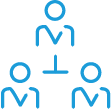Risk management process
Risk






The following two levels have been distinguished in the risk management process:
- the PZU Group level – ensuring that the PZU Group attains its business objectives in a safe manner appropriate to fit the scale of the risk incurred. Monitored at this level are the limits and risks specific to the PZU Group such as: catastrophic risk, financial risk, counterparty risk and risk concentration. The PZU Group provides support for the implementation of an integrated risk management system, including the introduction of compatible mechanisms, standards and organization of an efficient operation of the internal control system (with particular emphasis on the compliance function), the risk management system (in particular in the reinsurance area) and the security management system in the PZU Group, and also monitors their ongoing application. The PZU Group dedicated personnel cooperates with the Management Boards of companies and managers of such areas as finance, risk, actuarial services, reinsurance, investments and compliance on the basis of pertinent cooperation agreements;
- the entity level – ensuring that the PZU Group entity attains its business objectives in a safe manner appropriate to fit the extent of the risk incurred by that entity. Monitored at this level are the limits and risk categories specific to the company and also, as part of the integrated risk management system, implemented are the mechanisms, standards and organization of an efficient operation of the internal control system (with particular emphasis on the compliance function), the risk management system (in particular in the reinsurance area) and the security management system..
The risk management process consists of the following stages:
Identification
Begins with the proposal to commence the creation of an insurance product, acquire a financial instrument, change the operating process, as well upon the occurrence of any other event which potentially results in a risk. The identification process takes place until the expiry of the liabilities, receivables or activities related to the given risk. The identification of market risk involves recognising the actual and potential sources of such risk which are then identified as to their relevance.
Risk measurement and assessment
Risk measurement and assessment are performed depending on the characteristics of the given risk type and the level o its relevance. The risk assessment is performed by specialised units. In every company, the risk unit is responsible for development of risk assessment tools and risk assessment process to the extent which specifies risk appetite, risk profile and risk tolerance levels.
Risk monitoring and control
This involves ongoing reviews of any variances from the assumed parameters, namely limits, thresholds, plans, values from the previous period, recommendations and guidelines issued.
Reporting
Allows efficient risk communication and supports risk management at various decision-making levels.
Management actions
These activities encompass among others risk mitigation, risk transfer, risk avoidance, specifying risk appetite, acceptance of risk tolerance levels, as well as tools which facilitate such activities, i.e. thresholds, reinsurance plans and reviews of underwriting policy.
